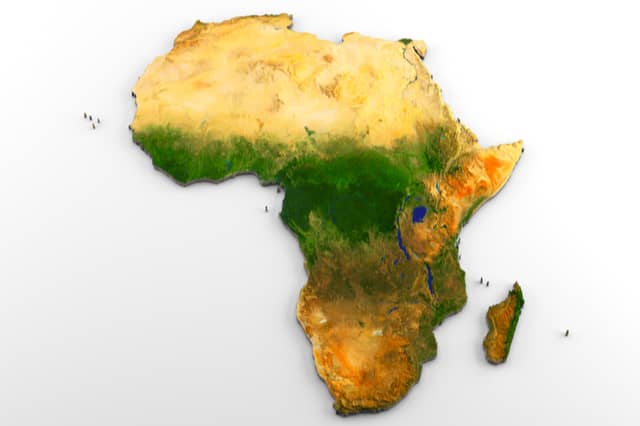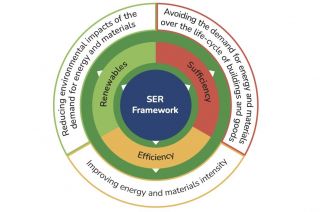
www.buildingsandcities.org/insights/commentaries/cop26-india-africa.html
India’s Role in Sub-Saharan Africa: COP-26 Expectations

By Ankit Kumar (U of Sheffield, UK), Joshua Kirshner (U of York, UK), Lata Narayanaswamy (U of Leeds, UK) and Enora Robin (U of Sheffield, UK)
In the past decade, growing attention has focused on
South-South cooperation in climate change mitigation, energy transitions and
infrastructure development, especially on the increasing role of BRICS
countries in sub-Saharan Africa (SSA). The questions of appropriate development
- reducing the dependencies on carbon-based energy (and mineral consumption)
for development - are highly pertinent to climate justice and an equity in
partnership.
India and China position themselves as leaders that can share knowledge, finance and technology with other countries in the Global South (Power et al., 2016). This engagement draws on a history of cultural exchange, ideas of South-South cooperation and a notion of ‘post-colonial’ solidarity. In the climate change negotiations under the UNFCCC, this ‘leadership’ has historically manifested as India and China defending the rights of ‘developing’ countries to emit and follow the path of development-as-modernisation laid out by ‘developed’ countries (Okereke & Coventry, 2016).
More recently, India and China in their status as ‘transition economies’ have shifted their stance by taking up emissions reduction responsibilities (Okereke & Coventry, 2016). They aim to balance clean energy transitions with continuing or increasing the pace of development and infrastructure provision. This dichotomy has come to shape India and China’s engagement in sub-Saharan African energy transitions. The argument that India and China have tackled the same sort of infrastructure gaps that currently afflict sub-Saharan African countries is increasingly used (Mawdsley, 2019). Notably, they now tackle these infrastructure gaps while transitioning to cleaner energy. As India and China expand their respective economic and political footprints, they also look towards raw materials, markets, and geopolitical interests beyond their borders (Mohan & Tan-Mullins, 2019).
Questions surrounding China’s role in extraction, land acquisition, debt-trap (and resource-backed loans) and neo-colonialism, or as an important locus of the global energy transition, have received increased attention over the past decade (Mohan & Tan-Mullins, 2019; Shen & Power, 2017). But less attention has focused on India’s growing role and ambitions in sub-Saharan Africa, where the historical presence of an Indian diaspora and its complicated colonial linkages offer India a different entry point than China.
The questions of energy and climate justice are highly pertinent to global climate negotiations. For example: how do the relationships between India and SSA nations shape, and are shaped by, the process of energy transitions? In what ways can new forms of transnational, notably South-South collaboration and/or assistance, facilitate energy transitions? As energy access gaps are exacerbated by ‘development-as-modernisation’ pathways, can the notions of ‘demand’ be reconceptualised to move away from energy intensive growth paradigms?
There is a need for rethinking the concept of energy justice. Conventionally, it rests on a three-legged framework, including distributional, procedural and recognition dimensions (Axon & Morrissey, 2020; Klinsky & Mavrogianni, 2020). It emphasizes that changes in energy systems must address inequalities in power and injustices across entire socio-energy systems. However, it falls short of enquiring how these injustices historically arise and embed themselves, or how historical experiences of shared injustices might complicate contemporary justice questions.
Driven by this complicated notion of justice, an understanding of India’s engagement in sub-Saharan Africa requires nuance. India has considerable expertise in green technologies, including bioenergy and solar PV. It has provided training to sub-Saharan African partners in biogas, solar technology, rural credit, and food processing through the Indian Technical and Economic Cooperation program since 1964. At the Paris COP-21, India partnered with France to create the International Solar Alliance (ISA) to support transitions to solar energy in tropical counties. The ISA provides technological, financial and knowledge support to Global South countries. While the ISA is portrayed as an initiative to ‘support’ energy transitions in the global South, evidence suggests it also feeds into a domestic manufacturing and export-oriented policy for India that views sub-Saharan Africa as a lucrative market for solar goods. As COP-26 gets closer, the US has indicated it might join India under the ISA. The South-South cooperation therefore has complications of ‘partnership’ or ‘co-option’ by Global North countries.
India’s sub-Saharan African engagement also has a pernicious side in other energy sectors, entrenching approaches to ‘development’ that hinge on high-carbon growth paradigms (as renewable energy are unlikely to meet India’s energy demand), including large investments in extractive resources. India’s rising middle class and breakneck urbanisation are leading to a rapid rise in energy demand. The pernicious side is revealed by the fact even if renewables could keep pace, this is likely to involve large-scale infrastructures like solar parks and battery installations. In addition, new buildings and infrastructures create long-term dependencies which is why it is essential to ensure material and energy demands are sustainable and capable of being fulfilled without relying on forms of neo-colonialism. These require raw materials, and the impacts of rapid extraction of minerals might affect ‘partners’ in SSA. Questions surrounding China’s role in extractive economies in Africa warn us of possible futures that India’s involvement might produce: the unabashed demand for energy, renewable or otherwise.
What is the alternative? The question of ‘demand’, and its link to development as modernity, needs critical examination to open alternatives. Scholars have indicated that the demand for energy leading to the extraction of minerals, land and cheap labour for solar panels, electric cars and batteries is adversely affecting certain global regions or places. It is important to ask: is the classical link between energy and development - access to more energy leads to more development through acquisition of goods and services that define modernity - helpful? What do other development pathways (e.g. a ‘pluriversal’ or decolonial framework) bring to our reimagining of ‘energy justice’? Would such rethinking of energy demand also lead to less demand on minerals and markets in sub-Saharan Africa? Could such reorientation of ideas establish different notions of energy and climate justice based on post-colonial South-South solidarity?
Acknowledgement
The authors thank the White Rose Collaboration Fund for supporting our ideas and collaboration. We gratefully acknowledge the contributions of our colleagues Gerard McCann and Jamie Van Alstine, who generously participated in discussions.
References
Axon, S., & Morrissey, J. (2020). Just energy transitions? Social inequities, vulnerabilities and unintended consequences. Buildings and Cities, 1(1), 393-411. https://doi.org/10.5334/bc.14
Klinsky, S., & Mavrogianni, A. (2020). Climate justice and the built environment. Buildings and Cities, 1(1), 412-428. https://doi.org/10.5334/bc.65
Mawdsley, E. (2019). Queering Development? The Unsettling Geographies of South-South Cooperation. Antipode, 0, 1-19. https://doi.org/10.1111/anti.12574
Mohan, G., & Tan-Mullins, M. (2019). The geopolitics of South-South infrastructure development: Chinese-financed energy projects in the global South. Urban Studies, 56(7), 1368-1385. https://doi.org/10.1177/0042098018794351
Okereke, C., & Coventry, P. (2016). Climate justice and the international regime: before, during, and after Paris. Wiley Interdisciplinary Reviews: Climate Change, 7(6), 834-851. https://doi.org/10.1002/wcc.419
Power, M., Newell, P., Baker, L., Bulkeley, H., Kirshner, J., & Smith, A. (2016). The political economy of energy transitions in Mozambique and South Africa: The role of the Rising Powers. Energy Research & Social Science, 17, 10-19. https://doi.org/10.1016/j.erss.2016.03.007
Shen, W., & Power, M. (2017). Africa and the export of China’s clean energy revolution. Third World Quarterly, 38(3), 678-697. https://doi.org/10.1080/01436597.2016.1199262
Latest Peer-Reviewed Journal Content
Acceptability of sufficiency consumption policies by Finnish households
E Nuorivaara & S Ahvenharju
Key factors for revitalising heritage buildings through adaptive reuse
É Savoie, J P Sapinski & A-M Laroche
Cooler streets for a cycleable city: assessing policy alignment
C Tang & J Bush
Understanding the embodied carbon credentials of modern methods of construction
R O’Hegarty, A McCarthy, J O’Hagan, T Thanapornpakornsin, S Raffoul & O Kinnane
The changing typology of urban apartment buildings in Aurinkolahti
S Meriläinen & A Tervo
Embodied climate impacts in urban development: a neighbourhood case study
S Sjökvist, N Francart, M Balouktsi & H Birgisdottir
Environmental effects of urban wind energy harvesting: a review
I Tsionas, M laguno-Munitxa & A Stephan
Office environment and employee differences by company health management certification
S Arata, M Sugiuchi, T Ikaga, Y Shiraishi, T Hayashi, S Ando & S Kawakubo
Spatiotemporal evaluation of embodied carbon in urban residential development
I Talvitie, A Amiri & S Junnila
Energy sufficiency in buildings and cities: current research, future directions [editorial]
M Sahakian, T Fawcett & S Darby
Sufficiency, consumption patterns and limits: a survey of French households
J Bouillet & C Grandclément
Health inequalities and indoor environments: research challenges and priorities [editorial]
M Ucci & A Mavrogianni
Operationalising energy sufficiency for low-carbon built environments in urbanising India
A B Lall & G Sethi
Promoting practices of sufficiency: reprogramming resource-intensive material arrangements
T H Christensen, L K Aagaard, A K Juvik, C Samson & K Gram-Hanssen
Culture change in the UK construction industry: an anthropological perspective
I Tellam
Are people willing to share living space? Household preferences in Finland
E Ruokamo, E Kylkilahti, M Lettenmeier & A Toppinen
Towards urban LCA: examining densification alternatives for a residential neighbourhood
M Moisio, E Salmio, T Kaasalainen, S Huuhka, A Räsänen, J Lahdensivu, M Leppänen & P Kuula
A population-level framework to estimate unequal exposure to indoor heat and air pollution
R Cole, C H Simpson, L Ferguson, P Symonds, J Taylor, C Heaviside, P Murage, H L Macintyre, S Hajat, A Mavrogianni & M Davies
Finnish glazed balconies: residents’ experience, wellbeing and use
L Jegard, R Castaño-Rosa, S Kilpeläinen & S Pelsmakers
Modelling Nigerian residential dwellings: bottom-up approach and scenario analysis
C C Nwagwu, S Akin & E G Hertwich
Mapping municipal land policies: applications of flexible zoning for densification
V Götze, J-D Gerber & M Jehling
Energy sufficiency and recognition justice: a study of household consumption
A Guilbert
Linking housing, socio-demographic, environmental and mental health data at scale
P Symonds, C H Simpson, G Petrou, L Ferguson, A Mavrogianni & M Davies
Measuring health inequities due to housing characteristics
K Govertsen & M Kane
Provide or prevent? Exploring sufficiency imaginaries within Danish systems of provision
L K Aagaard & T H Christensen
Imagining sufficiency through collective changes as satisfiers
O Moynat & M Sahakian
US urban land-use reform: a strategy for energy sufficiency
Z M Subin, J Lombardi, R Muralidharan, J Korn, J Malik, T Pullen, M Wei & T Hong
Mapping supply chains for energy retrofit
F Wade & Y Han
Operationalising building-related energy sufficiency measures in SMEs
I Fouiteh, J D Cabrera Santelices, A Susini & M K Patel
Promoting neighbourhood sharing: infrastructures of convenience and community
A Huber, H Heinrichs & M Jaeger-Erben
New insights into thermal comfort sufficiency in dwellings
G van Moeseke, D de Grave, A Anciaux, J Sobczak & G Wallenborn
‘Rightsize’: a housing design game for spatial and energy sufficiency
P Graham, P Nourian, E Warwick & M Gath-Morad
Implementing housing policies for a sufficient lifestyle
M Bagheri, L Roth, L Siebke, C Rohde & H-J Linke
The jobs of climate adaptation
T Denham, L Rickards & O Ajulo
Structural barriers to sufficiency: the contribution of research on elites
M Koch, K Emilsson, J Lee & H Johansson
Disrupting the imaginaries of urban action to deliver just adaptation [editorial]
V Castán-Broto, M Olazabal & G Ziervogel
Nature for resilience reconfigured: global- to-local translation of frames in Africa
K Rochell, H Bulkeley & H Runhaar
How hegemonic discourses of sustainability influence urban climate action
V Castán Broto, L Westman & P Huang
Fabric first: is it still the right approach?
N Eyre, T Fawcett, M Topouzi, G Killip, T Oreszczyn, K Jenkinson & J Rosenow
Social value of the built environment [editorial]
F Samuel & K Watson
Understanding demolition [editorial]
S Huuhka
Data politics in the built environment [editorial]
A Karvonen & T Hargreaves



Latest Commentaries
Climate Mitigation & Carbon Budgets: Research Challenges
Thomas Lützkendorf (Karlsruhe Institute of Technology) explains how the research community has helped to change the climate change policy landscape for the construction and real estate sectors, particularly for mitigating GHG emissions. Evidence can be used to influence policy pathways and carbon budgets, and to develop detailed carbon strategies and implementation. A key challenge is to create a stronger connection between the requirements for individual buildings and the national reduction pathways for the built environment.
Decolonising Cities: The Role of Street Naming
During colonialisation, street names were drawn from historical and societal contexts of the colonisers. Street nomenclature deployed by colonial administrators has a role in legitimising historical narratives and decentring local languages, cultures and heritage. Buyana Kareem examines street renaming as an important element of decolonisation.